Peru's rich cultural identity —defined by its mestizo roots and vibrant traditions— owes much to the enduring legacy of the Afro-Peruvian community. From music and dance to literature, cuisine, sports, and religion, Afro-Peruvians have made invaluable contributions to the nation's collective heritage.
Since June 4, 2006, Peru marks Afro-Peruvian Culture Day, honoring the artistic achievements and cultural expression of Afro-Peruvians.
This commemorative date was established in 2006 by Law No. 28761, passed by the Congress of the Republic.

Music
Afro-Peruvian music includes unique genres such as:
• Amor Fino: Lyrical duel accompanied by guitar.
• Canto de Jarana: Lively musical-literary competition performed by Marinera Limeña singers.
• Copla: Sung or recited during interludes of the Marinera Norteña.
• La Cumamana: Competitive singing style that addresses a wide range of themes.
• Decimas: 10-line stanzas that address a wide range of topics with subtle humor, literary skill, and wit. When sung, they are known as Socabon.
The Afro-Peruvian music was studied and spearheaded by cultural icons like: Victoria and Nicomedes Santa Cruz, Porfirio Vasquez, Jose "Pepe" Vasquez, Lucha Reyes, Susana Baca, Eva Ayllon, Ronaldo Campos, Lucila Campos, Caitro Soto, Arturo "Zambo" Cavero, and the Ballumbrosio family.

Some instruments of identity for the Afro-Peruvian music are:
• Cajon Peruano: Banned during the era of slavery for being considered pagan and to prevent the singing of the "Panavilo," a type of song that expressed the laments of the enslaved condition. Since 2007, this percussion instrument has been recognized as National Cultural Heritage. Since then, the International Cajon Festival has been held.
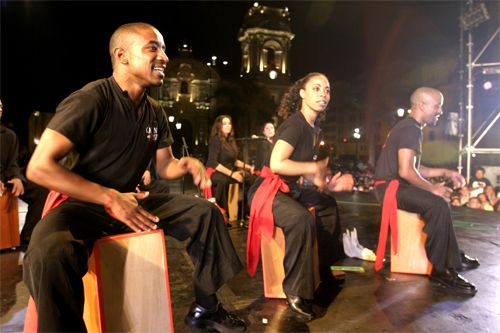
• Checo: A gourd-based percussion instrument used in dances like the Baile de Tierra, and in genres like Festejo and Lando.
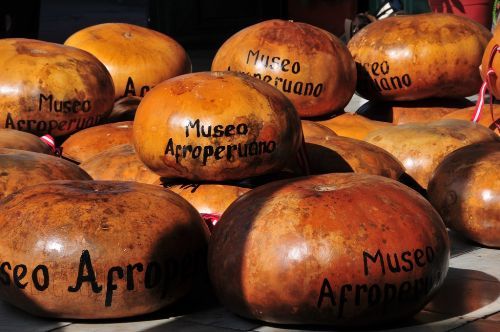
• Cajita Afroperuana: A small wooden box struck rhythmically with a stick, also recognized as a Cultural Heritage of the Nation since 2007.
• Huiro: Made from a ribbed gourd scraped with a wooden tool, dating back to the 18th century.
• Quijada de burro (donkey's jawbone): Played by striking the loosened teeth to produce a distinctive rattle.
Even dance steps like the zapateo, with their rhythmic heel strikes, become percussive instruments in their own right, further blurring the lines between music and movement in Afro-Peruvian traditions.
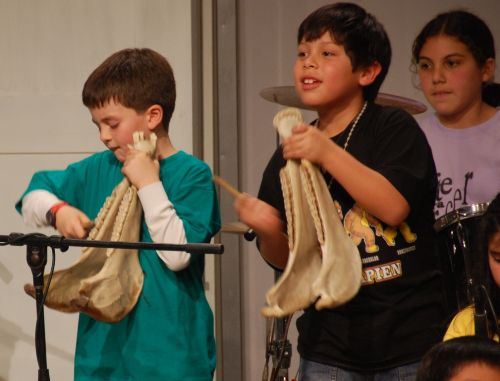
Dance
Dance of Afro-Peruvian roots stands out for its joy, rhythm, energy, and cadence as its main attributes. Among the emblematic dances: Festejo, Alcatraz, Zamacueca, Inga (a festive erotic dance), Baile de Tierra —still practiced in Zaña district, Chiclayo province, Lambayeque region—, the competitive footwork dance Agua Nieve; Lando; the Son de los Diablos, performed during carnival celebrations; and Tondero, a dance performed in pairs.
Likewise, Hatajo de Negritos and Las Pallitas —collective male and female dances, respectively— have been declared Cultural Heritage of the Nation and Intangible Cultural Heritage of Humanity.

Literature, arts, and sports
The legacy of Afro-Peruvian culture to national identity is also expressed in literature by:
• Enrique Lopez Albujar: Author of the celebrated novel "Matalache."
• Ricardo Palma, who wrote "Tradiciones Peruanas" (Peruvian Traditions)
• Antonio Galvez Ronceros
• Enrique Verastegui
• Nicomedes Santa Cruz, whose educational legacy for Peruvian culture is found in diverse poems, poetry, and decimas; and in whose honor Afro-Peruvian Culture Day was established on his birth date.
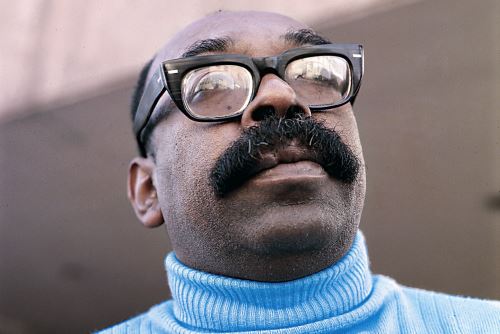
In the field of visual arts, during the 19th century, the portraitist Jose Gil de Castro and the costumbrista artist Pancho Fierro stood out.
Peruvian sports have brilliant representatives in disciplines such as:
Volleyball: Lucha Fuentes, Cecilia Tait, Denisse Fajardo, Gina Torrealba, Sonia Ayaucan, Angela Leyva, Clarivett Yllescas, among others.
Soccer: Teofilo Cubillas, Hector Chumpitaz, Valeriano Lopez, Julio Baylon, Victor Zegarra, Julio Cesar Uribe, Geronimo Barbadillo, Julio Melendez, Juan Jose Muñante, Paolo Guerrero, Jefferson Farfan, Pedro Gallese, Luis Advincula, Paolo Guerrero, and many more.
Boxing: Mauro Mina and Oscar Rivadeneyra.
Athletics: Fernando Acevedo, among others.
Surfing: Maria Fernanda Reyes, among others.
Religion
Devotion to Señor de los Milagros (Lord of Miracles) is the most representative religious expression worldwide and has carried a huge Afro-Peruvian component since its origins.
The image was painted by an Afro-descendant of Angolan origin, and the chants that accompany the procession bear an undeniable African reminiscence.
It is precisely during the procession that the Afro-Peruvian presence becomes most visible in the streets, dressed in the traditional purple habit.
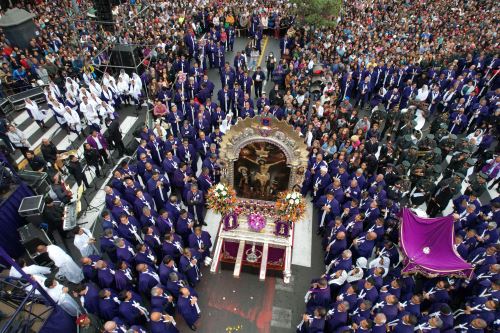
Through faith and devotion, this presence has been even more significant with the figure of the first Afro-descendant saint in the Americas, born in Lima: Saint Martin de Porres —a mulatto, the son of an Afro-Peruvian woman and a Spaniard— who joined the Dominican Order as a friar.
Despite the prejudice of his time, he was recognized as God's chosen one.
He was canonized on August 6, 1962, by Pope John XXIII. Today, he stands as a representative of Christian Catholic faith across the Americas.
Gastronomy
Peruvian gastronomy is heir to a series of cultural contributions among which the Afro-Peruvian legacy stands out:
• Anticuchos: Made from beef heart.
• Sangrecita: Prepared with chicken blood.
• Choncholi: Made from beef and pork intestines.
• Chanfainita: A stew made with beef lungs.
• Carapulcra: Prepared with dried potato and accompanied by pork or chicken).
• Morusa: A kind of mashed Ica lima beans, slices of pork, and bacon; in other cities, such as Nasca, it is known by the name "Charapana."
• Tacu Tacu: A kind of compact fried tortilla made with beans and rice, served with stews and fried foods of all kinds and abundant sarza criolla (onion relish).
Exponents of Afro-Peruvian cuisine include Teresa Izquierdo, who helped keep the Afro-Peruvian culinary tradition alive in national gastronomy, as well as Esther Cartagena, a well-known representative of Chincha cuisine.
Together with food, the Afro-Peruvian contribution is also expressed in desserts:
• Turrón de Doña Pepa: A traditional sweet that accompanies the Lord of Miracles festivity and dates back to 1800.
• Ranfañote: One of the oldest in Lima, linked to the colonial era and made with pieces of bread fried in lard and bathed in syrup, later accompanied by pecans and walnuts.
• Frejol Colado: A typical sweet during Holy Week in Chincha and Cañete.
• Chapana: A sweet native to Chincha, prepared with cassava, chancaca (unrefined sugar), anise, and wrapped in banana leaves. It is a snack very commonly found in the streets of Chincha, Ica, Lima, and other Peruvian cities.
According to the 2017 population census, the Afro-Peruvian community accounts for around 3.6% of Peru's total population.
The largest Afro-Peruvian communities are found in the localities of Zaña (Lambayeque region), Barrios Altos, La Victoria, Malambo (Lima Metropolitan Area), the town of El Carmen (Chincha, Ica region), and the town of Yapatera (Piura region).
Peru has celebrated Afro-Peruvian Culture Day with the aim of promoting visibility and recognition of this community's contributions to national identity among our population.
This date was chosen in honor of Nicomedes Santa Cruz Gamarra's birthday (June 4, 1925). He was one of the most recognized exponents of this group, and this year marks the centenary of his birth.
(END) LZD/MAO/JMP/MVB
Published: 6/4/2025